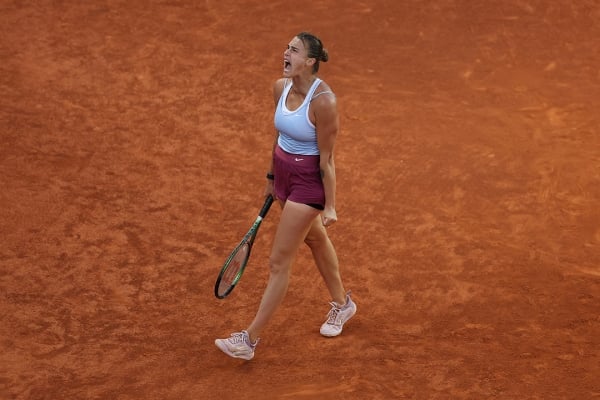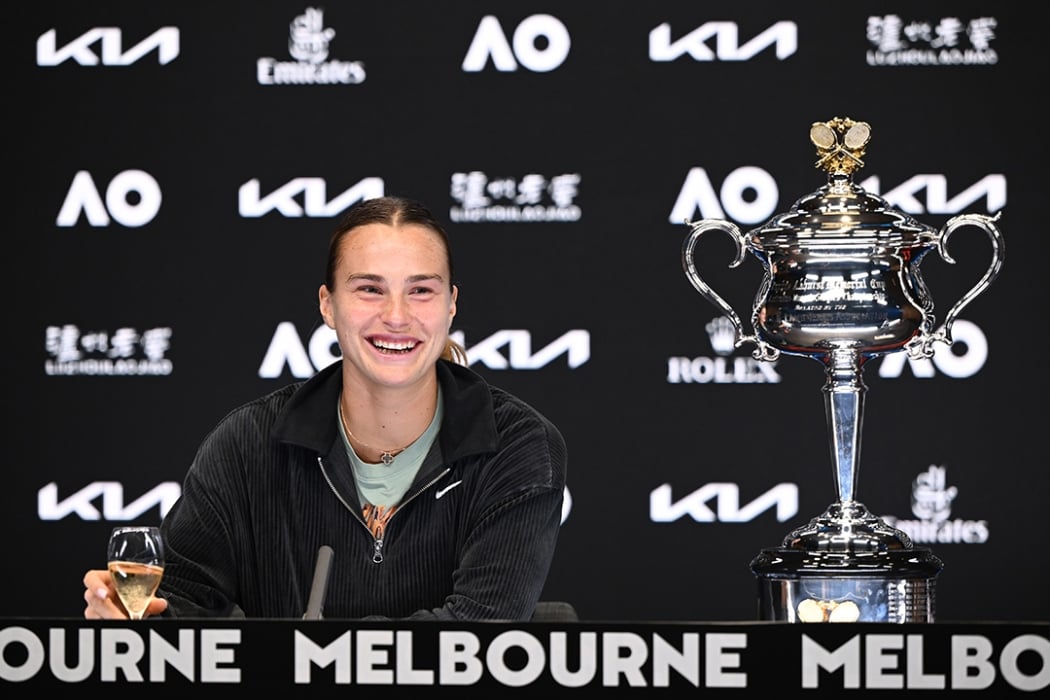After beating Iga Swiatek in a memorable three-set Madrid Open final, Aryna Sabalenka took the microphone for the trophy ceremony and turned to her Polish rival.
“It’s always tough battles against each other. You always push me to the limits,” Sabalenka said.
Sabalenka, who won her first major title at Australian Open 2023, is the tour’s hottest player, leading the WTA Finals points race after winning three titles from five finals – more finals before Rome than any woman has managed in 11 years.
REPORT: Sabalenka stands tall to win maiden major
She perhaps has Swiatek to thank for what has so far been her finest ever campaign.
“I definitely respect her a lot,” Sabalenka said of the world No.1, whose ranking she is intently chasing.
“She's a great player, and what she did last season and what she keeps doing, it's really motivating me a lot to improve, to keep working hard, to keep fighting.
“This year matches (against her) is completely different matches than it was last year. I improved a lot, and I really want to win against her, because she's such a great player.”

Swiatek noted Sabalenka’s professionalism and dedication to fitness. And Sabalenka, who at age 25 appears stronger and fitter than ever, revealed the reigning Roland Garros and US Open champion forced her to prioritise this aspect of her career.
“Swiatek, she's moving better,” Sabalenka said at the Miami Open.
“The first matches I played against her, I felt like physically I'm not ready. I'm getting tired after a few points and that's not how I'm going to win this match. So we spoke with my fitness coach to improve my fitness more.
"Every time when someone is beating you, it's pushing you to think about what you have to improve and this is how you keep moving.
“If someone beat me, I go watch my match. I take some lessons from there.”
Swiatek’s loss to Sabalenka in Madrid was a rare defeat in a final.
She had won 13 of her previous 15 – including three major finals – and at one stage was on a 10-match, 20-set winning streak in deciders. She had not lost a clay-court final in four years, winning two each in Stuttgart, Rome and Roland Garros in between.
The player who inflicted those two defeats was Barbora Krejcikova. She upstaged Swiatek in a thrilling Ostrava final in October 2022 – after which she thanked Swiatek “for bringing the best out in me” – and repeated the feat at the WTA 1000 Dubai final in February.
"I'm really sorry for today, but I'm really glad that I beat you!" ?
— wta (@WTA) October 9, 2022
Ostrava champ @BKrejcikova before some kind words for her opponent ?#OstravaOpen pic.twitter.com/XlPjBtq3KK
Unsurprisingly, Krejcikova also took inspiration from Swiatek’s performances in 2022, which included a 37-match winning streak – the best on the WTA tour since 1997 – and eight titles.
So dominant has Swiatek been that it emerged she has won a higher percentage of sets 6-0 (8.9%) than any woman this century – a figure that improves at WTA 1000 level.
“When I see what she's doing and what she was able to achieve and how she's playing and how she's unbeatable … it just really motivates me,” the Czech told WTA Insider. “It's a great feeling if I can go and practice with her or play a match against her. That is such a big challenge for me.”
HIGHEST PERCENTAGE OF SETS WON 6-0
(All tour-level events since 2000)
| Player | Matches | Sets Played | Sets won 6-0 | 6-0 % |
| Iga Swiatek | 198 | 439 | 39 | 8.9% |
| Martina Hingis | 311 | 686 | 56 | 8.2% |
| Serena Williams | 897 | 1993 | 140 | 7.0% |
| Monica Seles | 194 | 440 | 30 | 6.8% |
| Lindsay Davenport | 445 | 996 | 65 | 6.5% |
(Source: StatsPerform)
Like Sabalenka, former world No.2 Krejcikova is enjoying a brilliant season.
She fell to 27th late last year after being sidelined with an elbow injury, but has returned to No.13 after winning three WTA titles in the past eight months. She is sixth in the 2023 points race.
The Ostrava final was widely considered the best women’s match of 2022. This year fans have enjoyed thrilling finals at both the Australian and Madrid Opens. Swiatek, Sabalenka and Krejcikova featured in at least one of them, if not multiple.
Consider it the Swiatek effect.
"The bar right now is Iga, and the dominance of what she did in 2022, we haven't seen for a long, long time,” former pro Nicole Pratt told ausopen.com.
"Players are now asking themselves: OK, how do I beat Iga? Because she is the standard.
RELATED: Shape, heaviness and forehand-dominance – the evolution of women’s tennis
“(You have to deal with) her physicality, and also what she's able to do with the ball at end range – she can turn something into offense when she was on defence. So a player has to mentally deal with that, because against most other players, that ball doesn't come back.
“I also think about her relentlessness; when she has a ball that deserves to be put away, it doesn't come back. The term I use is 'take care of business'.
“There's an urgency in everything she does.”
.@iga_swiatek flying on the Rome clay pic.twitter.com/mzZOOaDN6K
— Jimmie48 Photography (@JJlovesTennis) May 14, 2023
Pratt also noted Swiatek rarely missed tournaments, and was impressed at this “robustness” required to compete continually at big events.
“Part of being No.1 is about consistency over time,” said Pratt, now Australia’s Billie Jean King Cup team coach.
"Not only is she consistent week-in and week-out, she gets on these runs where she just completely dominates, and wins back-to-back-to-back. When you try to describe consistency, I feel like that's sort of the layering of consistency she's achieving. (In the past few years) the consistency of players at the top winning tournaments wasn't there.
“Since Iga, it's been there. And now we're seeing it with Sabalenka – she's winning, and she's going to be around for a while. And (Elena) Rybakina as well.”

Women’s tennis has a storied history of dominant champions emerging, who subsequently elevate the overall level of play.
Chris Evert was the clear No.1 of the 1970s until Martina Navratilova wholly dedicated herself to training and fitness and wrested control of the tour in the 1980s. Like Sabalenka, Evert upped her fitness regime, introducing weights and training like a track athlete. After spending three years in Navratilova’s shadow at No.2, Evert overcame her arch rival in a classic 1985 Roland Garros final and returned to world No.1.
Then along came Steffi Graf, blending power and athleticism in a way not even the great Navratilova could repel. Of their six meetings in major finals, Graf won four.
Graf dominated until Monica Seles rose in the early 1990s with unparalleled intensity and power off both wings.
Her approach foreshadowed the rise of Venus and Serena Williams, who in the late 1990s propelled the sport into a new era. Their unprecedented serving prowess, all-court weaponry, firepower and athleticism forced current rivals Martina Hingis and Lindsay Davenport – and future rivals Jennifer Capriati, Kim Clijsters, Justine Henin, Amelie Mauresmo and Maria Sharapova – to attain a level in the 2000s they perhaps never thought possible.
"I always express my gratitude, she was an inspiration because she pushed us all,” Henin wrote of Serena in a Legends’ Voice piece for Eurosport. “I worked harder thanks to her."
Pratt’s career overlapped with this golden era of the sport.
“I feel really blessed, to a certain degree, that I actually was in and around and saw probably the last 30 years of the cycle of dominance from players on the WTA tour,” said Pratt, who believes the sheer quality of players on tour had a profound impact on her game.
“(In 2002) I was No.35 in the world, but I wanted to be No.1. (My approach became) how do I go from 35 to 1? I was 5-foot-3, playing against 6-foot opponents. So I had to be in the best possible shape I could possibly be, I couldn’t cut corners. I had to take physical confidence into the court, knowing I'd done the work.
“Players are still doing that today.”
From that era, Serena endured at the top by far the longest. And interestingly, Swiatek’s name was frequently linked with Serena’s during her outstanding 2022 campaign.
Yet while Swiatek may recall Serena statistically, Pratt thinks she more closely resembles Graf and Seles.
HIGHEST PERCENTAGE OF SETS WON 6-0
(Open Era)
| Rank | Player | Matches | Sets Played | Sets won 6-0 | 6-0% |
| 6 | Steffi Graf | 981 | 2166 | 236 | 10.9% |
| 7 | Monica Seles | 706 | 1560 | 163 | 10.4% |
| 17 | Iga Swiatek | 198 | 439 | 39 | 8.9% |
(Source: StatsPerform)
"(Comparisons with Graf) would be that relentlessness we discussed. Monica is the other one that comes to mind, in terms of that constant pressure, showing up, determination,” Pratt said.
“It's like those two players (were focused on) walking on the court and almost getting off as soon as possible. And to a certain degree, literally killing opponents. (They were saying) I'm gonna give you nothing, and if it means I walk off with a 6-0 set, then that's what I'm going to do.
"It's interesting discussing where Iga's at. I reckon in about two or three years' time, we'll really know: did Iga earn the same recognition or accolades as those players? We know she's breaking records right now. Can she continue to do that?”
Given how Swiatek is inspiring her rivals to close the gap she created, it would be extraordinary if she kept doing so.





